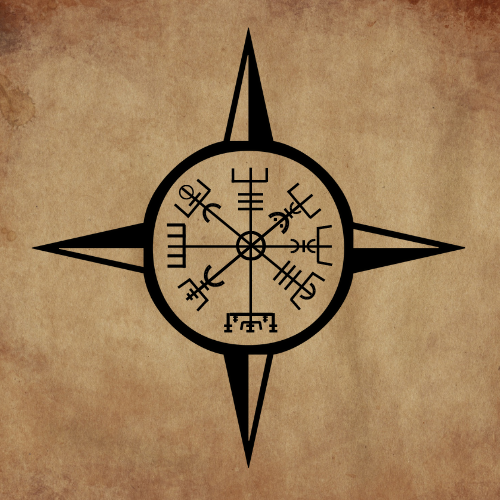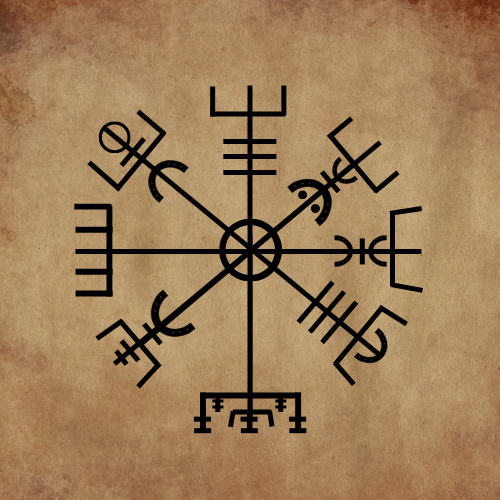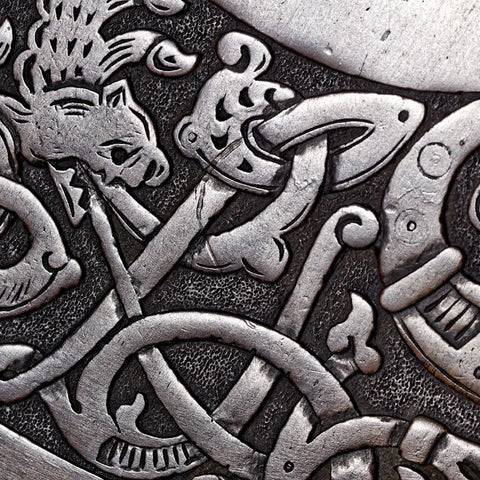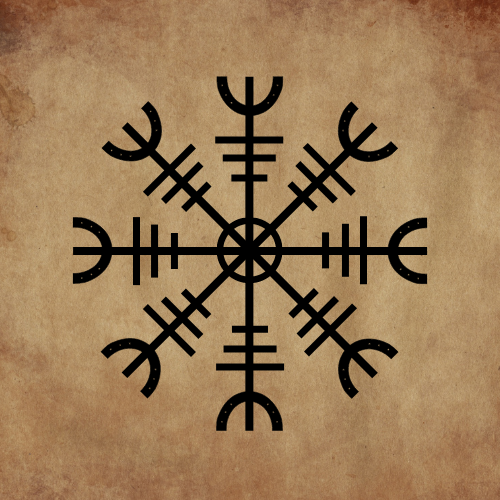Vegvisir Symbol (Norse Mythology And Modern Times)
In the intricate tapestry of Vegvisir Symbol Norse mythology, there exists a symbol that transcends time, weaving its way from ancient legends to the fabric of modern consciousness.
Imagine navigating the stormy seas of life with an ancient compass, an ethereal guide to lead you through turbulent waters.
Enter the Vegvisir, a mystical emblem that beckons both the curious and the seekers of direction.
As we embark on this journey, we'll unravel the mysteries of the Vegvisir, exploring its roots in Norse mythology, its relevance in contemporary times, and the timeless wisdom it holds.
Join us as we navigate the currents of history, bridging the gap between myth and modernity with the Vegvisir as our compass.
Let the exploration begin, and may the symbols of the past guide us to newfound insights in the present.
Vegvisir Symbol Origins
Introduction Of Old Norse Religion
The arrival of the first people in the Iceland region around 874 CE brought with them the Old Norse religion, encompassing the worship and belief in Norse gods, Sir and Vanir.
Magic In Norse Religion
The Norse religion included concepts of magic, outlining its various applications for personal success.
Icelandic Magical Staves
The settlers and their successors in Iceland created several magical staves, symbols designed for channeling magic.
Prominence Of Vegvisir (Viking Compass)
- Among the notable staves is Vegvisir, also known as the Viking Compass, believed to prevent one from losing their path when carried.
Huld Manuscript And Wayfinder Symbol
- According to the Huld manuscript, Vegvisir is referred to as one of Iceland's magical staves, with the English translation being "Wayfinder."
- Geir Vigfsson wrote the Huld manuscript in 1860 around the village of Akureyri, Iceland, assembling it from earlier literary pieces containing magical staves.
- Notably, there are no preceding illustrations of the Vegvisir symbol.
Key Takeaways
- Guidance and Protection: Vegvisir, the Viking Compass, symbolizes guidance and protection, especially during stormy and challenging times.
- Magical Stave: As a magical stave, Vegvisir is believed to prevent individuals from losing their path when carried, serving as a Wayfinder in the intricate tapestry of Norse magic.
- Eight-Pointed Symbol: Characterized by its eight-pointed shape, resembling a compass, Vegvisir holds symbolic significance, representing direction and orientation.
- Integration of Pagan and Christian Symbols: The Vegvisir's origins are intertwined with the merging of Pagan and Christian symbols in Europe, reflecting a blend of cultural and religious influences.
- Contemporary Significance: Despite emerging approximately 160 years ago, Vegvisir continues to captivate modern audiences, with interpretations ranging from an ancient Germanic rune to a symbol of guidance in popular culture.
- Helm of Awe (Aegishjalmur): Aegishjalmur, another magical stave, is associated with fear-inducing protection, featuring an eight-pointed design and a circle at its center.
- Syncretism in Magical Practices: Icelandic magical rituals, including the use of Vegvisir, showcase syncretism by blending Christian invocations with references to Norse deities, trolls, and giants.
- Modern Cultural Adoption: In contemporary times, Vegvisir has become a symbol adopted in various forms such as apparel, tattoos, and jewelry, reflecting its enduring cultural impact and symbolic resonance.
What is the Viking Compass?
| Characteristics | Description |
| Shape | Eight-pointed symbol resembling a compass |
| Purpose | Provides direction and protection, especially in storms |
| Mention in Huld Manuscript | "If this sign is carried, one will never lose their way" |
The Viking compass is not from the Viking Age, which spanned the eighth to eleventh centuries.
However, the Huld Manuscript, compiled in the second half of the 19th century by Geir Vigfusson, mentions Vegivsir symbol or Sign Post.
It is a compilation of 30 mystical symbols from various eras and their meanings. "If this sign is carried, one will never lose your way in storms or bad weather, even in unfamiliar surroundings," Vegvisir's intention states.
As a result, people painted the symbol on the person's forehead to assure that they did not become disoriented upon leaving home. Additionally, they allegedly drawn the symbol using blood.
Many referred to Vegvisir symbol as a compass because it has eight points. It originates from Iceland, densely populated by direct ancestors of actual sea-traveling Vikings.
This, though, is a bit of a prolepsis. Some Vikings used the concept of eight directions. Further, they may have had their directional finding instruments, such as the Uunartoq disc or sunstones.
However, most of their navigation was based on visual clues like the stars, flight patterns of birds, the sun, etc. So instead of just being a portrayal of a compass like we know it, Vegvisir's eight "arms' signify something different.


Vegvisir Symbol is not from the Viking Age

Norse Mythology In Living Tradition
Ninth-Century Settlement By Vikings
Iceland was discovered by Vikings in the ninth century, many of whom sought refuge from political changes in mainland Scandinavia, aiming to preserve their democratic way of life.
Diverse Founding Population
According to sagas and DNA findings, around 30% of Iceland's founding population had Irish and Scottish origins. The question of their status—whether slaves, offspring of Nordic and Celtic unions, or a combination—remains open.
Multi-Religious Beginnings
The Norse and Celtic settlers, including some 100% Nordic Vikings, embraced Christianity, resulting in Iceland's multi-religious foundation. Both cultures shared a strong sense of tradition, mysticism, and storytelling.
Literary Legacy Of Icelanders
Icelandic Norse, known for oral traditions, absorbed the literary influence of Irish and Scots who were already highly literary. Icelanders gained a reputation for being exceptional loremasters and poets, serving as court skalds during the Viking Age.
Icelandic Sagas
The sagas, recounting the first 300 years of Icelandic history, showcase warriors, feuds, farmers, legal battles, and love lives. Critics suggest they may be historical fiction, yet they remain an extraordinary literary achievement preserving Iceland's creativity and past.
Population Evolution And Cultural Preservation
Iceland's population declined between the Viking Age and modern times, with minimal immigration. This isolation connects Icelanders closely to their Viking forefathers. The Icelandic language, remarkably similar to Old Norse, has preserved Viking history, faith, poetry, and lore.
Iceland: Custodian Of Viking Knowledge
Almost all we know about Viking history comes from Iceland—sagas, Eddas, and more. Exceptionally, Saxo Grammaticus' work acknowledges the influence of Icelandic loremasters.
Religious Diversity And Tolerance
Initially, Iceland embraced religious diversity, coexisting with various faiths. In 1000, the Althing made a unique decision, adopting Christianity as the official religion but allowing private spiritual practice.
This period of religious diversity, lasting about 120 years, contributed to Icelanders' acceptance of their pagan heritage.
RELATED: 135 Gratitude Affirmations For Any Time, For Anyone
Archeology and Burned Magic Books from Viking Age
Lack of Archaeological Traces
Prior to three Icelandic books, the Vegvisir symbol, Aegishjalmur, and Icelandic rune staves left no archaeological evidence. Wayfinders weren't carved on ships, and Aegishjalmur wasn't found on helmets, creating a silent archaeological record.
Challenges in Viking Archaeology
Unlike Greek and Roman archaeology etched in marble, Viking archaeology poses challenges as many practices, mentioned by Davidsson, leave few traces due to rapid biological decay.
Sigrdrifumal of the Poetic Edda
An older source, the Sigrdrifumal, describes a Victory Driver urging Sigurd to carve magic runes on various objects. This poem, published in the 13th century but composed earlier, reflects the mystical nature of rune magic.
Oral Tradition and Grimoires
Magic knowledge, mostly transmitted orally, was occasionally compiled into grimoires during the Middle Ages. The Rauskinna of Gottskálk Nikolásson, a bishop known for "pagan magic," was an attempt, but it was lost after his death.
Icelandic Magic Books
Icelandic magic books, unlike the vast Rauskinna, were mostly small, known as galdrakver. These notebooks contained spells and symbols, and their knowledge is documented through witch trials.
Destruction and Persecution
Many Icelandic magic books, including the Galdrakver, were destroyed, especially during witch trials. Accused witches were spared, but their writings and tools were burned, leading to a scarcity of surviving evidence.
Surviving Grimoires from the 1800s
Most surviving Icelandic grimoires are from the 1800s. The Age of Enlightenment and the decline of the Church's legal power allowed magical practices to emerge from shadows, but fragmented information was gathered on the fly.
Eclectic Nature of Grimoires
Grimoires today are eclectic collections of magical fragments rather than coherent theories or practices. This results from both how the data was acquired and stored and intentional design. Icelandic grimoires weren't meant for novices but to supplement oral teachings from knowledgeable mentors.

The connection of Vegvisir and Aegishjalmur Symbol to Christian Mysticism
| Symbol | Meaning and Use |
| Aegishjalmur | Helm of Awe, worn for protection and fear-inducing |
| Vegvisir | Compass, protection against storms and bad weather |
People have recently named Vegvisir symbol and Aegishjalmur "Christian" symbols or stated that the symbols have origins in "Christian mysticism," including some well-written and well-researched works. Even though this is a perfectly reasonable assumption, it is false for several reasons:
Christianity categorically forbids magic, many times in severe terms. Furthermore, most Protestant denominations and the Catholic Church have historically condemned magic, viewing it as the domain of false prophets or even the devil.
Remember that the Church burnt the magic texts, sometimes together with the magician, so Vegvisir symbol and Aegishjalmur have few surviving sources.
Several notable warlocks and wizards were Christian priests in Icelandic history, like Gottskálk, but becoming a bishop at the time was more about the study, wealth, and family ties than it was about holiness.
When the Church could no longer ignore their magical deals, they frequently banished priests and bishops. As a result, Icelandic magic has never been "Christian" because the Church hasn't recognized it.
A "Christian" symbol represents Christianity, such as a holy dove or a cross. This is not the case with the Vegvisir and Aegishjalmur.
Norse artifacts like rune stones don't show these symbols. But, any Christian churches haven't discovered them.
What Connection Does the Vegvisir have with Solomon?
Uncertain Descent From Clavicula Salomonis
Proving that symbols in Iceland directly descended from Clavicula Salomonis' star-shaped pentacles or any known work is impossible.
Unlike the Testament of Solomon, which links to Kabbalah, Christianity traditionally lacks symbols.
Christian Influence In Grimoires:
The Notary of Solomon and the Lesser Key include Christian images and concepts, emphasizing mysticism as a religious activity rather than practical magic.
However, assumptions persist despite clear distinctions in the grimoires.
Christian Ideas On Runestones
Remaining runestones in Iceland are filled with Christian ideas and imagery, akin to voodoo practices.
The texts also contain numerous references to Christianity, invoking Thor, Odin, Norse gods, trolls, and giants.
Syncretism And Spiritual Blending
Professor Glenn Holland notes that magical rituals often stem from syncretism—blending and identifying multiple religious cultures.
Diverse Spiritual Powers In Magic
Icelandic magic texts reflect this by combining Christian invocations with references to Norse deities, trolls, and giants.
Wizards or witches in Icelandic magic texts must conjure diverse and opposing spiritual powers to charge spells.
Invocations to Thor, Odin, and protective charms attribute influences to both Christian and Norse spiritual entities.
Magic And Syncretism Worldwide
Globally, the blending of religious appeal and spirit assignment in magic is evident, seen in practices in South America or New Orleans.
Magic engages the spirit world to alter the natural world, and recruiting the correct spirits for the task is considered essential.
Circular Symbols And Vegvisir Distinction
While numerous circular symbols share a similar appearance, none of them contains the Vegvisir.
It's intriguing that some dismiss the idea that Icelandic symbols were passed down by Norse forefathers while simultaneously presuming the Vegvisir's originality as a Christian sign due to its resemblance to Solomon symbols.
RELATED: 163 Uplifting “I Am” Affirmations To Create Positive Change
Aegishjalmur
Aegishjalmur, another magical stave, is similar in ideas in appearance. Thus, people confused it with Vegvisir.
In fact, like a magic channeler, Aegishjalmur not only appears different but also serves an entirely different meaning.
Aegishjalmur is an eight-pointed magical stave known as the "Helm of Awe." The Helm of Awe's eight trident points are all generally identical, unlike its Way Finder cousin.
A circle is also included in the center of the symbol. It protects the warrior and put fear into the enemy when drawn on the warrior's forehead.

The dragon Fafnir wore the Helm of Awe in the Poetic Edda, written and edited by Snorri Sturluson.
The dragon credited his accomplishment in protecting his treasure horde to the Helm of Awe he wore.
As it turned out, Sigurd killed Fafnir and claimed Aegishjalmur, presumably a physical object.
Other Icelandic Magical Staves
| Stave | Purpose |
| Thjofastafur | Reveals the face of a thief when drawn and filled with water |
| Vatnahlifir | Worn under the right arm for protection against drowning |
| Gapaldur and Ginfax | Used in wrestling to ensure victory in specific positions |
It was critical to follow the directions precisely if the chosen symbol was to have the desired impact. Anyone should draw correctly the staves and sometimes speak a spell. Let's look at some of the other staves you can come across in Iceland.
Thjofastafur
This sigil protects you against thieves but it will not prevent you from getting robbed. Instead, it will show you the thief's face.
Firstly, carve the Thjofastafur into the bottom of a wooden bowl first. Secondly, you fill it with water and yarrow flowers. Lastly, recite a special charm for the water to expose the thief's face.
RELATED: 143 Abundance Affirmations To Live A Fulfilling & Prosperous Life
Vatnahlifir
Anyone should wear this stave under the right arm to guard against drowning. Drowning would have been a serious threat; fishing has long been an essential element of Icelandic culture.
Swimming lessons became compulsory for all Icelandic children starting in 1940.
Drowning mortality has decreased throughout time, and there are now extremely few drowning deaths in the country.
Everyone has a safe location to learn because almost every town in Iceland has a public swimming pool or hot springs.
Gapaldur and Ginfax
These staves aid in the wrestling sport known as Glma. They painted the stave on paper or wood to ensure victory and placed in certain positions in one's shoes.
For example, Gapaldur went under the right foot's heel, while Ginfaxi went under the left foot's toes.
The Modern Concept Of "Vegvísir"
| Modern Usage | Interpretations |
| Neo-paganism | Seen as an ancient Germanic and Viking magical rune |
| Popular Culture | Adopted in apparel, tattoos, and jewelry |
Nowadays, "vegvisir" is well-known among neo-pagans, musicians, reenactors, and fans of Viking-othemed TV shows and other mass productions.
People cannot overlook its application in the apparel industry, as well as in tattoos and jewelry. In addition, reenactors commonly use it for shield decorating or costume needlework.
This contradictory group acknowledges "vegvisir" is an ancient Germanic and Viking magical rune sign. The purpose of the symbol is that of a compass.
It protects Viking warriors during sailing, providing protection and guidance. However, only popular literature and romance fiction may offer such an interpretation from the last 30 years.
Today, many people like to interpret symbols and develop their theories based on their imagination. For example, some people suggest that it is a Way finder to find one's way in the Nine Realms, while others take it a step further.
Conclusion
The Huld manuscript, a modern collection of spells describes the Vegvisir as a neo pagan symbol. The book says, "If this sign is carried, one will never lose one's path in storms or bad weather, even when the way is unknown."
Ancient people wrote the Huld manuscript in the nineteenth century, around eight centuries after the Viking Age ended. Some of it may stem from when the pre-Christian Norse religion was still alive and well.
But, Christianity and magical tradition brought in from more southern regions of Europe greatly impacted it.
Thus, just because something is mentioned in the Huld manuscript does not mean that pre-Christian Norse or other Germanic peoples were aware of it, much less accepted it as part of their religion.
On the other hand, there were no evidence that the Viking centuries or before knew or used this symbol.
But, they possibly knew and used the symbol at the time as a protection against storms or bad weather.
Further, it's also possible that people imported or invented the symbol afterwards. Finally, we simply do not know if this was a Viking symbol.
RELATED: 123 Positive Affirmations For Improving Your Work Life
Frequently Asked Questions
What is the Vegvisir symbol, and what does it represent in Norse mythology?
The Vegvisir, also known as the Viking Compass or Wayfinder, is a runic symbol from Norse mythology. It is believed to provide guidance and protection to those who possess it, helping them find their way through rough seas or life's challenges.
What is the historical origin of the Vegvisir symbol?
The Vegvisir has roots in ancient Norse culture and is often associated with the runic and magical traditions of the Vikings. While its exact historical origin is challenging to pinpoint, it embodies the spiritual and navigational wisdom of the Norse people.
What does the Vegvisir symbol look like?
The Vegvisir is typically depicted as an eight-armed symbol, resembling a compass. In its traditional form, the arms are adorned with runic characters, and the central point represents the navigational focus.
How was the Vegvisir used by the Vikings?
According to Norse legend, the Vegvisir was a magical tool that aided sailors in finding their way home, even when faced with stormy seas. It was believed to have protective qualities, ensuring a safe journey.
Does the Vegvisir have a connection to modern times?
Yes, the Vegvisir has transcended its historical roots and is now a popular symbol in modern times. Many individuals use it as a talisman or tattoo to symbolize guidance, protection, and a connection to Norse heritage.
Is the Vegvisir associated with a specific faith or religion?
Originally rooted in Norse mythology, the Vegvisir is not tied to a specific faith. However, it is often embraced by those interested in Norse spirituality, Asatru, or individuals seeking a symbol of guidance and protection.
Can anyone use the Vegvisir symbol, or is it reserved for specific groups?
The Vegvisir is widely embraced and can be used by anyone, regardless of their cultural or religious background. Its universal appeal has made it a popular symbol among those interested in Norse culture and spirituality.

